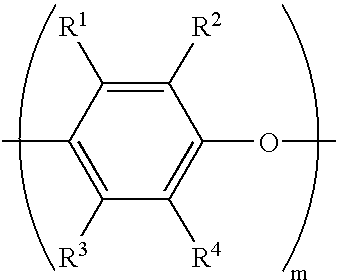Electrically conductive thermoset composition, method for the preparation thereof, and articles derived therefrom
a technology of thermoset composition and electric conductive material, which is applied in the direction of conductive materials, non-conductive materials with dispersed conductive materials, fuel cell details, etc., can solve the problems of limited commercial adoption and achieve the effects of improving lubricity, increasing the abrasive action of polymers, and improving compatibility and adhesion
- Summary
- Abstract
- Description
- Claims
- Application Information
AI Technical Summary
Benefits of technology
Problems solved by technology
Method used
Image
Examples
example 4
PREPARATIVE EXAMPLE 4
[0127] This example describes the preparation of a poly(salicylate)-capped 0.25 IV PPE Resin / Styrene blend. Using the procedure from Example 3 of U.S. Pat. No. 4,760,118 to White et al., a poly(salicylate)-capped polyphenylene ether was prepared from poly(2,6-dimethyl-1,4-phenylene ether) having an intrinsic viscosity of 0.25 dl / g and 10 weight percent (based on PPE) polysalicylate. The product capped PPE was dissolved in styrene as a 35 weight percent solution for use as Preparative Example 4.
example 5
PREPARATIVE EXAMPLE 5
[0128] This example describes the preparation of methacrylate-capped 0.15 IV PPE Resin / Styrene blend.
[0129] A 22 liter 3-necked round-bottomed flask was charged with 8 kg (17.6 lbs) of styrene monomer (Ashland Chemical; Lot # 074B00508). The solution was warmed to 85.degree. C. with constant stirring. During this time 8 kg (17.06 lbs) of poly(2,6-dimethyl-1,4-phenylene ether) having an intrinsic viscosity of 0.15 dL / g was added. After addition was complete, the reaction mixture was stirred at 85.degree. C. for approximately 1 hour until the resin had dissolved. The reaction mixture was then treated with 936.2 g of N,N-dimethylaminopyridine (DMAP, Avocado Labs, Inc.) and 958 g (925 ml, d=1.035g / ml) of methacrylic anhydride (Monomer-Polymer Dajac Labs) then heated at 85.degree. C. for 300 minutes. The reaction mixture was then cooled and the resin mixture emptied into a 5 gallon container. A small sample was precipitated into methanol and submitted for analysis. B...
examples 6-9
PREPARATIVE EXAMPLES 6-9
[0131] Preparative Example 6 describes the preparation of Methacrylate-capped 0.12 IV PPE Resin / Styrene blend.
[0132] A 100-gallon stainless steel reactor was charged with 68.03 kg (150 lbs) of Styrene monomer (Ashland Chemical; Lot # 074B00508). The solution was warmed, under a nitrogen blanket, from 39-79.degree. C. over 75 minutes. During this time, 68.03 kg (150 lbs) of poly(2,6-dimethyl-1,4-ph-enylene ether) having an intrinsic viscosity of 0.12 dL / g was added. After addition was complete the reaction mixture was stirred at 74-85.degree. C. for 85 minutes to ensure dissolution of the PPE resin. The reaction mixture was then treated with 936.2 g of N,N-dimethylaminopyridine (DMAP, Avocado Labs, Inc). After 20 minutes, 8.156 kg (7.88 liters, d=1.035 g / ml) of methacrylic anhydride (Monomer-Polymer Dajac Labs) was added. The reaction mixture was heated at 85.degree. C. for 305 minutes. The reaction was then cooled to approximately 50.degree. C. and the resin ...
PUM
| Property | Measurement | Unit |
|---|---|---|
| Percent by mass | aaaaa | aaaaa |
| Percent by mass | aaaaa | aaaaa |
| Percent by mass | aaaaa | aaaaa |
Abstract
Description
Claims
Application Information
 Login to View More
Login to View More - R&D
- Intellectual Property
- Life Sciences
- Materials
- Tech Scout
- Unparalleled Data Quality
- Higher Quality Content
- 60% Fewer Hallucinations
Browse by: Latest US Patents, China's latest patents, Technical Efficacy Thesaurus, Application Domain, Technology Topic, Popular Technical Reports.
© 2025 PatSnap. All rights reserved.Legal|Privacy policy|Modern Slavery Act Transparency Statement|Sitemap|About US| Contact US: help@patsnap.com



